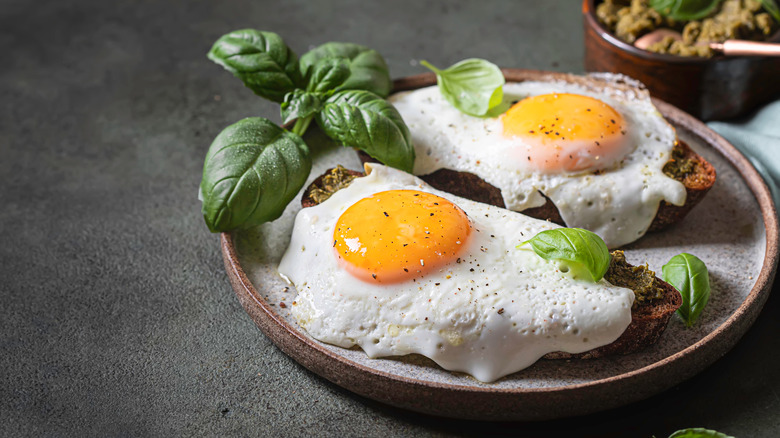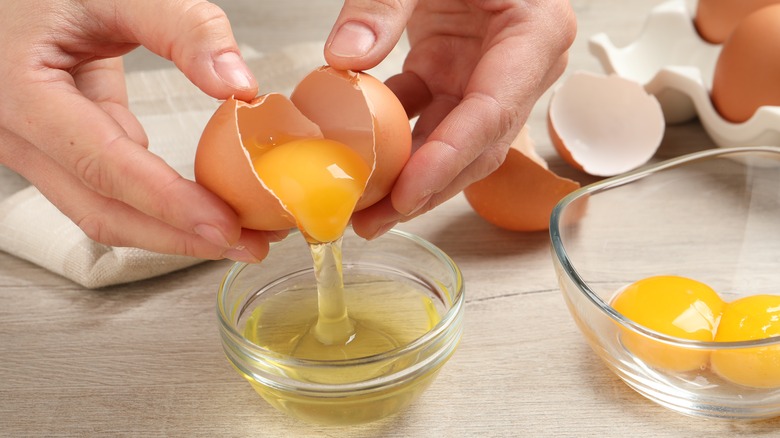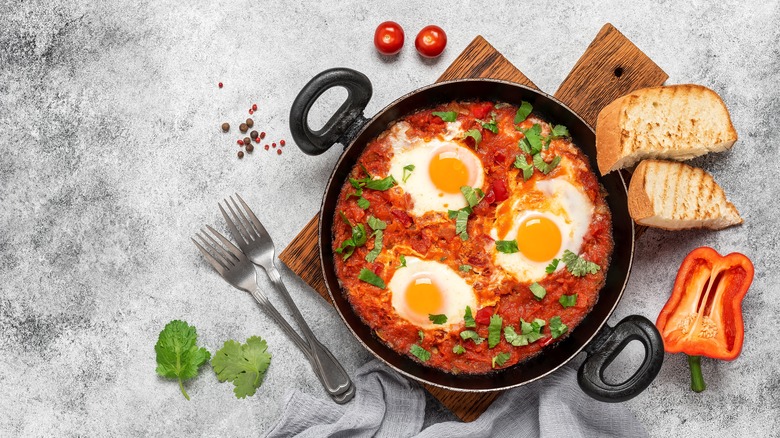The Hack To Guarantee A Runny Egg Yolk Is More Obvious Than You Think
Eggs are quite challenging to cook for something that gets microwaved in fast food restaurants and busy suburban kitchens. It's the holy grail at culinary schools. Egg day is dreaded: students cook hundreds of eggs until they can perfectly make a French omelet, poach, and fry an egg. There's a reason why it's incredibly hard to achieve a tender but fully cooked egg white and a runny yolk: they cook at different temperatures.
Egg whites contain 40 different proteins, each setting at a different temperature. The first to set hits the mark at 141.8 F, but the last (and most prevalent) — ovalbumin — doesn't set until the temp rises to 183.2 F. Egg yolks, on the other hand, begin to thicken at 149 F and finish setting at 158 F. Once the yolk hits 176 F, it reaches the crumbly, dry, hard stage. That's still seven degrees under a fully set white. That's a failed culinary school course. That's a predicament.
If you're not trying to pass the egg test at culinary school, we have a wildly obvious hack — so obvious, we can't believe we haven't been doing it forever. Egg whites cook at different temperatures and times than egg yolks. Okay. So, cook them separately. Cook the white, then add the yolk on top and finish it — it seems effortless.
The so-obvious-it-hurts method to perfectly runny egg yolks, detailed
We've been separating egg whites from yolks for centuries. We even started making cloud eggs 400 years ago, where we whip up little nests of meringue-like egg whites, bake them in the oven, and then add the yolk on top to finish cooking. It's such a similar process that it's truly mind-boggling that we haven't made the jump to this method for fried eggs.
Journalist-turned-pastry-chef Rebecca Eisenberg explains the process. First, separate the yolk from the white. Be careful not to burst the yolk, or this won't work. Set the yolk aside. Heat a pan with oil, butter, ghee, coconut oil — whatever fat tickles your fancy. Cook the egg white until set. Eisenberg says it's okay if there's still a touch of unset white on top, but it should be mostly cooked. Once your egg white is done, gently tip your egg yolk (again, being careful not to burst it) atop the middle of the white. Allow the yolk to come up to temperature so it starts to thicken, and then remove it from the hot pan to prevent further cooking. The beauty of this method is that because the egg yolk is floating on top of a fully cooked egg white, it's safe from a puncture from the bottom when you slide under the egg with a spatula.
Things this method will revolutionize
When you utilize this oh-so-simple method of cooking the egg whites first and then adding the yolks just to set, your eggs are sure to come out perfect every time. Eggs over easy and toast? No problem. Corned beef hash and eggs? Coming up.
Beyond breakfast, think about the possibilities for baked egg dishes! Never again will your shakshuka feature either snotty, raw egg whites or hard-boiled egg yolks. Instead, the whites will be set, and the yolks will be just starting to thicken and perfectly, viscously runny. Creamy baked eggs will always be perfect. In Turkish eggs and breakfast pizzas, too.
This will not help to perfectly poach an egg unless you use wizardry (or a syringe) to reinsert the yolk into the egg white. For that, you're still going to want to either cook them sous vide or in a pot of boiling water.


